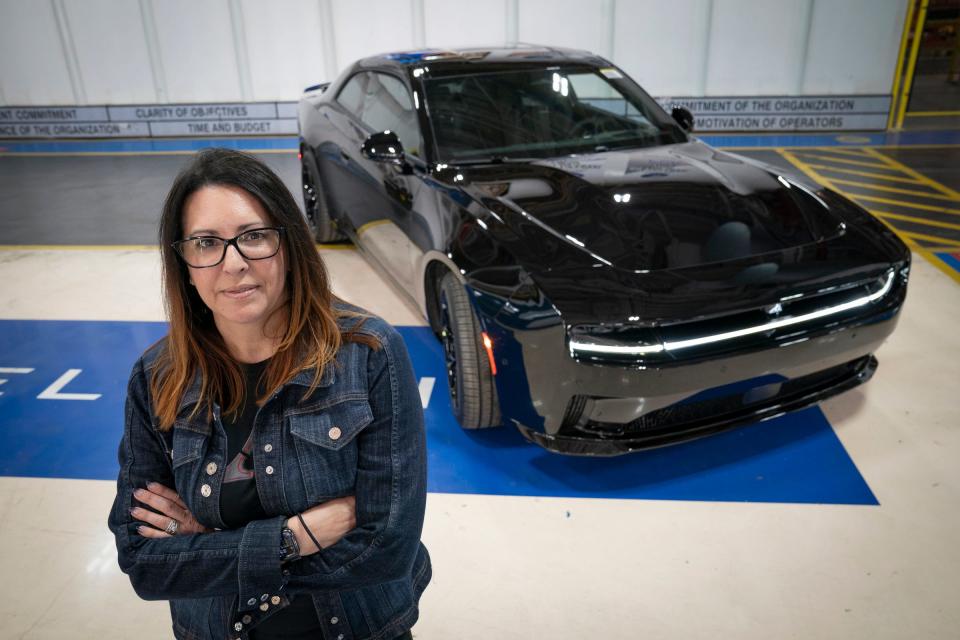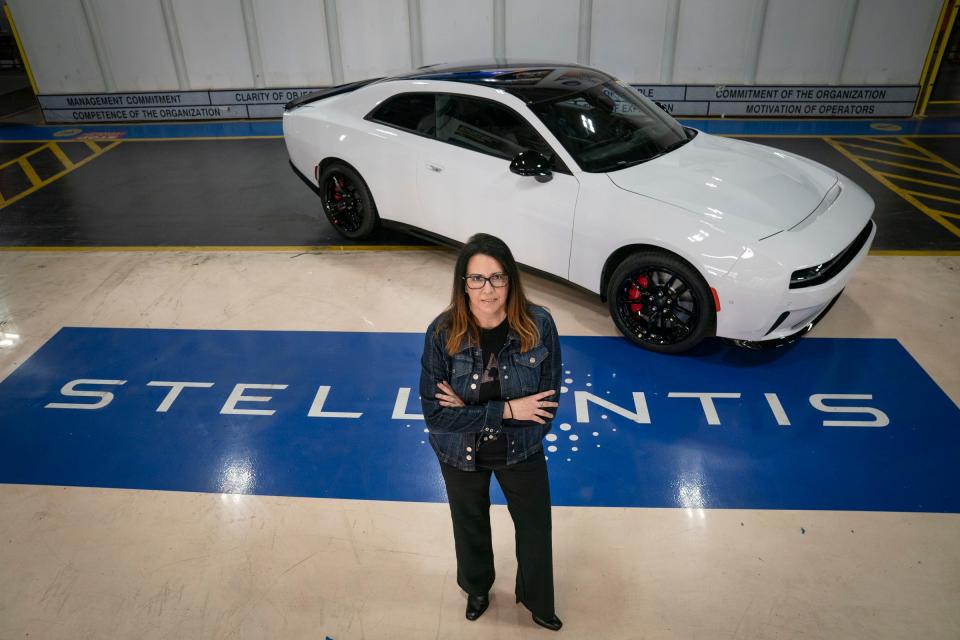Dodge muscle car chief engineer had key experience that set her on career path
Audrey Moore’s journey to becoming the chief engineer for the upcoming electric Dodge Charger might have started with a nudge from a teacher.
“When I was in second grade, Mrs. Sutter — I was really good in math — and she looked at me and she just said, ‘You’re going to be an engineer.’ I’m like what? An engineer. What does that mean?”
That idea of becoming an engineer “kind of just stuck,” Moore told the Free Press during a recent conversation about her role leading the launch of the Stellantis brand’s first electric muscle car.
It helped, too, that when she was growing up, Moore said she spent lots of time in the garage with her dad. Whether it was during oil changes or brake repairs, his message to her was you do your own work on cars.

Along the way, an aunt who worked as an engineer for General Motors was “always whispering” in her ear and other family members with ties to the auto industry.
A long path back to Dodge
The 49-year-old, who grew up in Farmington and now lives in Bingham Farms, eventually got her engineering degrees at Wayne State University. But Moore credited a drive with her parents while she was in college, a time when she was still trying to figure out where she might end up, with another key nudge.
“I saw the Dodge Durango, and I was just like, 'That thing is gorgeous. I want to go work for a company that makes cars like that,' and that is eventually what kind of put me on my path to come work here,” she said. “So Dodge has been in the blood for a while.”
Moore’s 25 years at the company that’s been Stellantis since the 2021 merger with Peugeot maker PSA Group didn’t begin with Dodge. She's been working in other roles, including commercial vans and Jeeps.
She led launches for the Cherokee in Belvidere, Illinois, and the Italian-made Renegade, a vehicle which is now being phased out for the U.S. market. She was also the global validation head for the Compass.
“And then I got this wonderful job to work on the next-generation Charger and Challenger, so that brought me into a whole different world of muscle cars and people who love horsepower and drifts and doughnuts and all sorts of things that Jeep people do not do,” she said. “I’ve done the Moab Trail with my Jeeps, and now I’m going to Roadkill Nights and doing drifting and to tracks and stuff, so it’s quite a unique experience between the programs that I’ve been on.”
EV must 'sound like a Dodge, drive like a Dodge'
This current chapter has been years in the making. The push to deliver Dodge’s first electric vehicle, planned for launch this summer, came with a mandate from Dodge CEO Tim Kuniskis. The mandate tied into expectations from a passionate fan base about what the Dodge brand represents.
This needed to be more than an electric vehicle, Moore said, it needed to be a muscle car.
“It’s got to do all those things that Tim has drilled into my head for the last three years. It’s got to sound like a Dodge, drive like a Dodge, feel like a Dodge … look like a Dodge,” Moore said. "I might be a little biased, but the car is fantastic."

Other EVs that she’s driven feel like electric vehicles, and Moore said that’s not the sense one gets from the new Charger. Perhaps that’s because it won’t only be an EV.
The company plans to launch two battery electric vehicle models this year — the 496 horsepower 2024 Dodge Charger Daytona R/T and a Daytona Scat Pack promising up to 670 HP (a “power shot” button will deliver 40 of that HP for 15 seconds) — as well as a Banshee EV high-performance model at some point. But gas-powered models, equipped with a new Hurricane inline-six engine, are slated for 2025.
Stellantis has focused on the idea of multi-energy platforms. It’s an idea that gets mentioned regularly in company briefings, and it’s a philosophy that might be paying off as a more complex picture of U.S. EV adoption comes into view.
Dealing with EVs comes with some extra challenges affecting those prepping this car for launch. Moore noted that charge times have to be accounted for in testing and other activities, things that aren’t in the mix for a gas-powered vehicle.
Some of the early cars are already on the roads around metro Detroit, and Moore said she put her name on the list to get one of the new Chargers as soon as possible. Her sons, 16 and 18, have been begging daily to know when she will be bringing one home, though she’s not so sure it would be a great idea to have a 16-year-old behind the wheel of the high-powered muscle car.
Moore’s husband, Rich Silbert, is also an engineer working for the company, in a different area (there’s also a 14-year-old daughter).
There are pros and cons, she acknowledged, to working in the same field as your spouse.
Hooked on Tim Hortons
“He knows when I’ve had the bad day … so like the door opens and he’s got the glass of wine waiting for me when I walk in the door. So there’s some benefit to it, but you have to learn when to shut off the work talk,” she said.
Moore's days currently involve daily travel to Canada after any virtual meetings with the leadership in Europe.
Tim Hortons in Canada is also a regular stop.
“It’s so different. The guys on my team always told me it’s different, and I didn’t believe them and now I’m addicted, totally,” Moore said.
Her preferred fix?
A “large double double, ‘cause you’ve got to get the cream and the sugar,” she said.
After that, it’s on to the Windsor Assembly Plant, where Moore and the plant manager go over the status of the current vehicle builds. She has to look over everything from vehicle testing to quality to reviewing any necessary changes and fixes.
“I’m 100% fully responsible for the vehicle. I’m responsible for design, cost, quality, execution, timing. The buck kind of stops here with me,” Moore said.
Windsor Assembly, where the Charger is being built, is a shift from the old versions of the Charger and Challenger. Both, along with the Chrysler 300, were built at the Brampton Assembly Plant, near Toronto.
A lot of work was needed, including almost six weeks of down time, to convert Windsor, a plant that has traditionally built minivans, for muscle car production.
That shift represents a lot of change, but the excitement in the plant has been palpable, she said.
That change also highlights the risk inherent in the launch, which will carry an extra burden because this is the first full EV from the Dodge brand. It's worth noting that any vehicle launch carries risks for an automaker and the executives in charge.
The previous generation Charger and Challenger also helped Dodge secure top spots in recent J.D. Power quality rankings, so perceptions of quality will be key in the future. Moore acknowledged there’s always a learning curve, but said her team took what they knew worked well from the past and integrated it into the current version.
“We held ourselves accountable to the quality, the targets that we exited out of Brampton,” she said, noting that “this plant has a very good quality history with the minivans.”
Contact Eric D. Lawrence: elawrence@freepress.com. Become a subscriber. Submit a letter to the editor.
This article originally appeared on Detroit Free Press: Dodge Charger chief engineer opens up about new car, her own career

